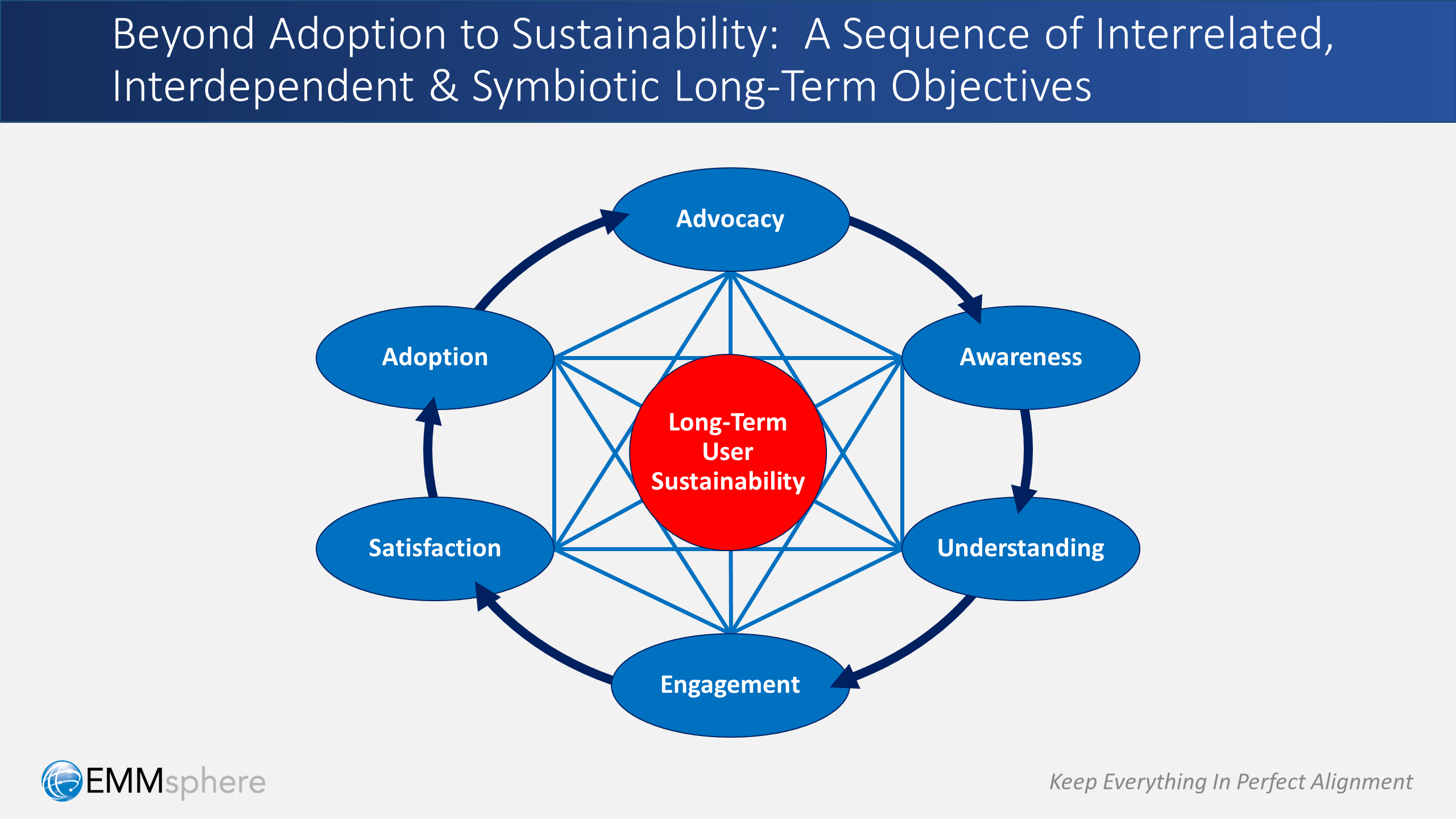
A Deep and Broad Topic
In the world of marketing technology deployment — or any technology deployment for that matter — it’s safe to say that few topics get more airtime than user adoption. Justifiably so, of course. As a result, we’re often asked to articulate our own perspectives on user adoption: how are they different?
Well, truth be told, our perspectives aren’t necessarily different. However, they’re certainly distinctive, in that we place more emphasis on topics that often get less attention.
Specifically, we strongly believe that organizations should take a holistic and long-term view of adoption — across interrelated objectives that both precede and succeed it — within the context of 4 dimensions:
- Time & place
- Stakeholders involved
- Decisions to be made
- Information available
Interrelated Objectives toward a Bigger Purpose

As most people will agree, there are a variety of objectives involved in creating strong levels of user adoption.
We call these “the bigger wheel of adoption.” Because while the objectives are interrelated and sequential in nature, they stretch beyond adoption per se, toward a bigger purpose: long-term user sustainability.
As shown in the diagram above, we believe there are 6 of these interrelated objectives — not coincidentally the smallest perfect number. And, to some extent, we also believe they even go in pairs.
So, let’s briefly discuss these objectives, each in their own right, and also with respect to the 4 dimensions we noted earlier.
Awareness & Understanding
These are the first adoption-related objectives that organizations should strive to achieve. Users need to be aware of the change that’s happening (e.g. purchasing and deploying a new solution), and they need to understand why it’s happening and what it means for them (i.e. what the solution offers and how it can improve their lives).
Viewing awareness and understanding with respect to the 4 dimensions we noted above:
- Time & place: relevant primarily during the earlier phases in a deployment cycle, e.g. during purchase decision and/or project initiation, crossing into solution design/configuration
- Stakeholders involved: executive leadership, project sponsorship, work managers and work assignees
- Decisions to be made: should we buy the platform, should we switch off our current solution, can this help us run better/faster?
- Information available: advocacy from the vendor (sales/marketing), independent research and references, platform demos and trials, internal communications & advocacy
As one can imagine, the main challenge here is to generate awareness and understanding even though there’s limited information available — and the information itself may be suspect due to the motivations and/or agendas of its sources (e.g. advocacy from sales, marketing, etc.).
Engagement & Satisfaction
Engagement and satisfaction are the undisputed heart and soul of adoption, and are by far the most important objectives. Users need to become actively engaged and fully satisfied with the solution’s capabilities, especially with respect to their specific roles, activities and responsibilities.
Viewing engagement and satisfaction with respect to the 4 dimensions noted earlier:
- Time & place: relevant primarily during the main phases of the solution deployment cycle, e.g. during design, configuration, validation, training, rollout (and continuing to post-rollout)
- Stakeholders involved: primarily work managers and work assignees, with project sponsorship and executive leadership to a lesser extent
- Decisions to be made: can the solution help me do my job, can it enhance my team’s performance, can it enhance the organization’s performance?
- Information available: hard evidence from hands-on experience, assistance from colleagues and solution experts, advice from best practices or outside practitioners (e.g. user groups)
A key point to keep in mind when considering engagement and satisfaction is this: if user’s are satisfied, they’ll be engaged — but not necessarily vice-versa. This is because even though users may be engaged, they’re often still striving to figure out their own conclusions based on their own experience with the solution. Their satisfaction will evolve as they figure out answers to questions such as:
Of course, users might take some advocacy into consideration at this point. But at the end of the day, they’ll rely more heavily on their own testimony.
In short: as far as users are concerned, satisfaction is the name of the game — and personal experience, more than anything else, will be the vehicle they take to achieve it.
Adoption & Advocacy
Which brings us to the final two objectives, adoption and advocacy. And with them comes an important difference vis-a-vis the earlier objectives we discussed above:
This might seem like a trivial point, but there’s a subtle distinction here that often gets comingled or conflated: in the end, user advocacy comes from satisfaction and adoption — but user satisfaction and adoption do not necessarily come from advocacy.
In other words, and only to some degree, advocacy may influence, but it does not directly cause, satisfaction and adoption (and awareness and understanding).
So, why should we care about them, and more pointedly, why should we care about advocacy?
Because while they’re not the means, they’re the outcomes — tangible, measurable results that certainly should be tracked.
But even more importantly: because they (particularly advocacy) spill over and influence other times & places, other stakeholders, and other decisions that ultimately roll “the bigger wheel of adoption” toward organization-wide and long-term user sustainability.
And in that sense, adoption and advocacy will still figure prominently with resect to the 4 dimensions we noted earlier:
- Time & place: relevant primarily during the tail-end phases of a solution deployment cycle, e.g. during post-rollout and ongoing maintenance and support — and the beginning of follow-on deployments to other groups or other divisions
- Stakeholders involved: primarily work managers and work assignees, but also project sponsors and executive leaders (especially when continuing to follow-on deployments)
- Decisions to be made: should we deploy the solution to other teams and constituencies? Can we quickly entice and onboard new groups or departments? Can we (or the vendor) consider this a “referenceable success”?
- Information available: metrics from solution performance reports, lessons learned from hands-on experience, and recommendation (advocacy) by adjacent colleagues, teams or divisions
Closing Thoughts
Needless to say, it’s impossible to do justice to all aspects of user adoption in a short space such as this.
However, let’s at least try to summarize with a few points of advice, which we hope will serve you well as you take steps to build adoption — and user sustainability — within your own organization:
- Keep objectives clearly delineated: as we noted above, the 6 key objectives around adoption (and beyond) are interrelated and it’s easy to mix and match — but doing so can inadvertently lead to confusion
- Be clear on time & place and stakeholders involved: the objectives of one constituency (e.g. leadership, users, or vendors) are not necessarily the same as those for another constituency — especially at different moments in time across the solution lifecycle
- Be mindful of sequence, dependencies, cause & effect: carefully consider of how one objective leads to another, and how these interrelated objectives set the stage to achieve your overriding long-term goal — organization-wide, and long-term, user sustainability
In short, stay focused on the bigger goal that goes beyond adoption and reaches toward sustainability — and be methodical and holistic in your approach to getting there.
Leave a Reply